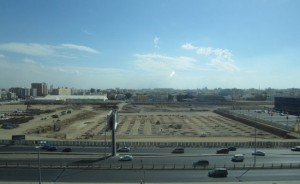Biennale Jogja XII Equator #2
Indonesian Visual Artists Encounter with Eqypt, Saudi Arabia, and Uni Emirat Arab
16. Nov. 2013 – 6. Jan. 2014
Curators: Agung Hujatnika a.k.a. Agung Hujatnikajennong and Sarah Rifky
Artistic Director: Farah Wardani
In this global era, contemporary art has become a part of cultural practice that also contributes to define the patterns of society’s lives in this new millenium, particularly in the urban environment. Urban societies in several parts of the world are now connected greatly by economic and political systems, and also by the global cultural systems that make it possible for two or more cultures to juxtapose, encounter and blend with each other. Globalization is characterized by the birth of unpredictable relations between the flows of capital, media technology, ideas and migrations of the agents. It involves dynamic movements of cultural collectives, information exchange through technology, economic transactions, etc, which do not depend on one great ideal or harmonious master plan. In this context, the metaphors of uncertainty, contingency and chaos are in fact relevant to describe the process of globalization that strays from the principles of social stability.
As the curatorial concept of the 2nd Equator Biennale , ‘Mobility’ starts from the perspective that sees the contemporary art practice as a manifestation of modes of productions – distributions – consumptions that apply in the global art scene. Globalization offers new routes of ‘mobility’ for the process of migration, exchange and crossings of the agents, in terms of both ideas and esthetics. As a result, the art world has gone through a siginificant expansion. The life cycles of art – as ideas or objects – becomes more complex. For artists, this can make things easier, as well provide new challenges. On one hand, new possibilities experiment esthetically through interactions with new social fields are opened up. But on the other hand, artists also face the new mechanism of unpredictable global multiplication, expansion, intensification and acceleration, which has potential to reduce their cultural autonomy as an individual.
To prevent the risks of rigid practice in linking this process of globalization and the art scene today, the concept of ‘Mobility’ will be manifested in activities with two main targets:
1) To understand and map the patterns of creation and production of art that have occurred through the migration of Indonesian and the Arab region artists.
2) To create new channels that offer new potential for migration/exchanges between artists from Indonesia and the Arab region, which means to encourage more esthetic experimentation as well as new artistic creations and productions.
The implementation of the concept will try to avoid the stereotypical assumptions attached to the cultures, demography and social/political/economic lives of the societies in the two regions. As a whole, this exhibition will present selected works of artists in two main criteria:
1) Artists (regardless of citizenship) who in the last 3 – 5 years have been migrating, crossing borders, staying and living in Indonesia and Countries of the Arab region.
2) Artists who are nationalities of Indonesia and countries of the Arab region who live and work as well as doing exchanges in and outside their countries.
However strong globalization has come to bring forth uniformity as an impact, in reality art practices in different societies and different cultural areas cannot be made uniform. Through ‘Mobility’, artists deal with the urgency to rethink the function and position of art in the society.


